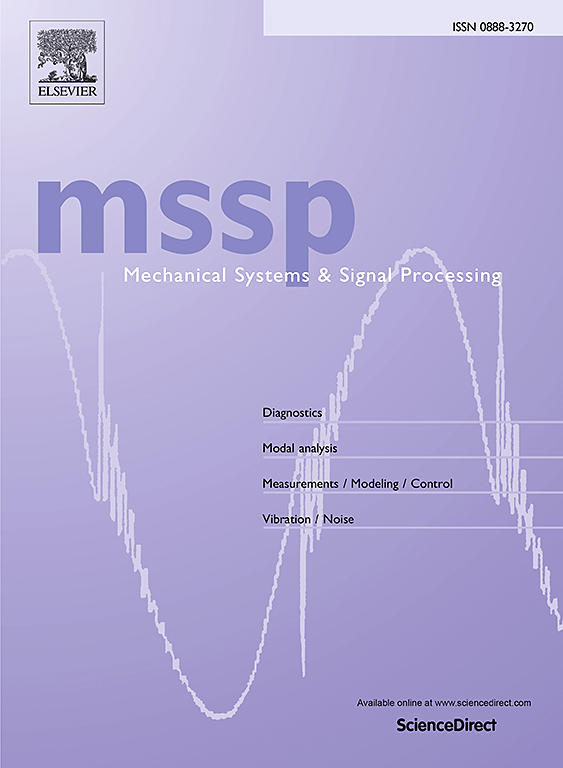Dynamic detection mechanism model of acoustic emission for high-speed train axle box bearings with local defects
IF 8.9
1区 工程技术
Q1 ENGINEERING, MECHANICAL
引用次数: 0
Abstract
Acoustic emission (AE), as a promising technology, is suitable for the fault diagnosis and state monitoring of high-speed train axle box bearings (HSTABs). However, the mechanism of the correlation between bearing states and dynamic AE signals remains unclear. Existing studies have failed to explain the relationship between contact deformation energy and dynamic root-mean-square (RMS) of the AE signals generated by HSTABs, while also neglecting the asperity-induced dynamic displacement and local defect-induced transient elastic waves. Moreover, there is no study on the attenuation behavior of AE waves in complete HSTAB. This paper presents an AE dynamic detection mechanism model of the HSTAB state, revealing the generation mechanism of AE waves by rough contact and local defect impact and their propagation characteristics. First, based on the load pattern of the HSTAB, a dynamic model was established considering asperity contact, local defect impact, and lubrication oil, and the dynamic contact force of the rollers was determined. Second, a mathematical model of the rough contact with RMS was established jointly with the contact force. Further, the attenuation features of the AE waves in the HSTAB and its housing were investigated, and an AE dynamic mechanism model was established. The model not only resolves the dynamic RMS characterization of the AE signals from moving bearings but also describes the relationship between the dynamic RMS and running speed, bearing state, and time scale. Finally, with different defective HSTABs as examples, the correctness of the model was verified by performing experiments on a full-size high-speed train test rig, providing a theoretical basis for the application of the AE technology in the diagnosis and quantitative analysis of bearing faults.
高速列车轴箱轴承局部缺陷声发射动态检测机制模型
声发射技术是一种很有前途的技术,适用于高速列车轴箱轴承的故障诊断和状态监测。然而,轴承状态与动态声发射信号之间的相关机制尚不清楚。现有研究未能解释接触变形能与hstab产生的声发射信号的动态均方根(RMS)之间的关系,同时也忽略了粗糙性引起的动态位移和局部缺陷引起的瞬态弹性波。此外,还没有对完整HSTAB中声发射波的衰减行为进行研究。本文提出了HSTAB状态声发射动态检测机制模型,揭示了粗糙接触和局部缺陷冲击声发射波的产生机理及其传播特性。首先,基于HSTAB的载荷模式,建立了考虑粗糙面接触、局部缺陷冲击和润滑油的动态模型,确定了滚子的动态接触力;其次,结合接触力,建立了与RMS粗糙接触的数学模型;进一步研究了声发射波在HSTAB及其外壳中的衰减特征,建立了声发射动力学机制模型。该模型不仅解决了运动轴承声发射信号的动态均方根特征,而且描述了动态均方根与运行速度、轴承状态和时间尺度的关系。最后,以不同缺陷hstab为例,在高速列车全尺寸试验台上进行了实验,验证了模型的正确性,为声发射技术在轴承故障诊断和定量分析中的应用提供了理论依据。
本文章由计算机程序翻译,如有差异,请以英文原文为准。
求助全文
约1分钟内获得全文
求助全文
来源期刊

Mechanical Systems and Signal Processing
工程技术-工程:机械
CiteScore
14.80
自引率
13.10%
发文量
1183
审稿时长
5.4 months
期刊介绍:
Journal Name: Mechanical Systems and Signal Processing (MSSP)
Interdisciplinary Focus:
Mechanical, Aerospace, and Civil Engineering
Purpose:Reporting scientific advancements of the highest quality
Arising from new techniques in sensing, instrumentation, signal processing, modelling, and control of dynamic systems
 求助内容:
求助内容: 应助结果提醒方式:
应助结果提醒方式:


